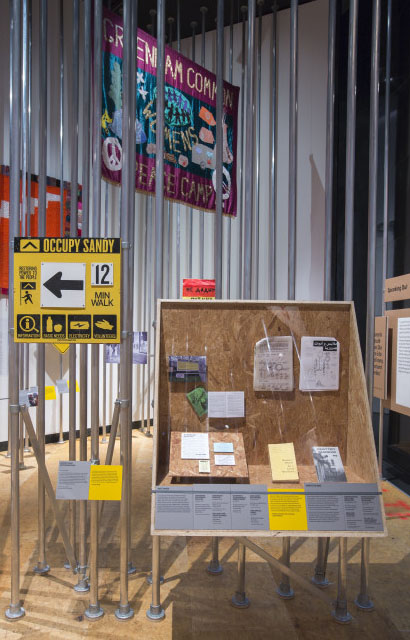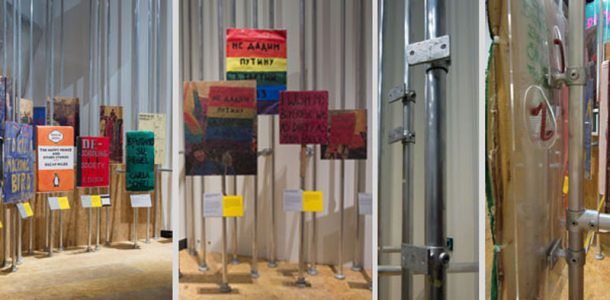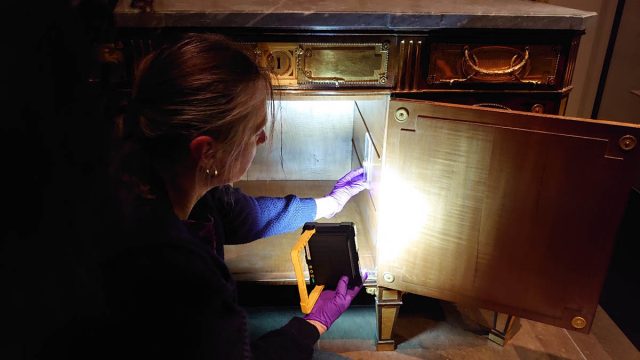by Clair Battisson, Senior Preservation Conservator
‘Disobedient Objects’ explored the powerful role objects can perform in support of movements for social change. ‘Immediate’, ‘alternative’ and ‘bold’ were just a few of the words used to shape the design concept and also Conservation’s decision making for repair and display. The exhibition in the V&A ran from the 26 July 2014 – 1 February 2015 and has also toured internationally (Figure 1).

As with all successful projects, time for comprehensive, collaborative planning is fundamental. Complex objects, second guessing the unknown and tight deadlines can add considerably to workloads. The lenders (some of whom needed to remain anonymous) and the object types were a little more unconventional than usual. For instance, we knew many of the objects had been produced in reaction to a particular event, made with materials at hand and, due to their use, were potentially quite fragile. Some of the challenges raised during early-stage group discussions included:
- Concerns about object condition, given unknown materials, use and storage
- How to retain a level of honesty and energy when presenting these objects within a museum environment
- Consideration of public reaction and possible interaction
- Ability to protect without adding barriers or museum signage
The Exhibition Department worked incredibly hard, both with lenders and the Government Indemnity Scheme (GIS) advisors, to arrange for a large number of objects to be on site well in advance of installation. This allowed Conservation to carry out condition and Insect and Pest Management (IPM) assessments and, with the lender’s permission, stabilize any objects without erasing signifiers indicative of their direct purpose. As a project team we were also able to discuss and make informed decisions for display.
The ‘Tiki Love Truck’, a multi-disciplinary vehicle, was too big to bring into the Museum prior to installation (Figure 2). However, it was essential it was assessed in advance as there were concerns surrounding certain aspects:
- Structure: ceramic tiles on a corroding metal body, abundance of mixed media embellishments, including wooden components
- Use: until recently a working vehicle
- Storage: external and unprotected from the elements for a number of years

Discussions with the relevant people in front of the vehicle meant issues and solutions were weighed up and agreed. Once the truck was brought on site following treatment, there were no surprises and conservation input became minimal. Discussing and solving all issues at an early stage and at source meant what was initially considered one of the more problematic objects, became one of the most straightforward.
Build design and materials play an essential role in every exhibition narrative. The choice of materials for ‘Disobedient Objects’ needed to be as responsive and resourceful as the objects displayed. After carefully considering the sensitivity of each object and taking into account budget constraints, it was agreed that Oriented Strand Board (OSB) could be used as the main build material with the understanding that all case interiors would be coated with several layers of sealant. Where objects required a more sensitive environment, Forex® covered in Oddy-approved fabric (a similar colour to the chosen OSB) was used. A clear and consistent language was agreed for all mounts and, with the knowledge that the exhibition would tour, re-useable and adaptable was also a part of the remit (Figure 3). A good working relationship with the contractors also meant any issues were discussed and solutions agreed as the build progressed off site.

It was important that the objects maintained a level of intimacy with the visitors, which meant established display restrictions, such as a one metre separation between an object and a visitor, wouldn’t always work. When considering this we also needed to bear in mind gallery location – at the entrance of the Museum – and as the exhibition was free, it would hopefully be very busy. It was essential that all small, portable objects were cased and due to size and impact the banners were naturally elevated. The placards, book blocks, vehicles, and figures were displayed in direct reach; a necessity for the objects’ significance and, for a large part, following the lenders’ ethics. After discussion with the lenders, these objects were covered by a wear and tear agreement outlining situations, responsibilities and outcomes, which needed to be understood and agreed with all relevant parties. A sensitive message at the beginning of the exhibition asked visitors to both enjoy and respect the works on display and two Gallery Assistants with an understanding of the potential issues and an agreed way of responding to any unwelcome interaction would always be present. A level of contingency was also agreed during the build design meetings. The poles and fittings on the backs of the placard and book block mounts were interchangeable which meant objects could be moved upwards or, if necessary, onto poles behind their original display location in order to create a little distance (Figure 4). For the figures, the surrounding poles were secured in locations that would allow for the addition of fine elastic roping to be tied from pole to pole to act as an informal reminder not to touch. Doing this at the planning stage meant contingency was worked into the scheme in advance and had it been necessary to introduce any of these steps, it was already agreed and would not disrupt the initial design scheme.

All documentation remained digital and, once complete, was made available to all relevant staff. Condition reports were produced at object arrival and kept as image based as possible. Status, i.e. ‘object’, ‘prop’, ‘remake’ was made clear at the early stages of planning, ensuring the required level of information was gathered for each individual item. Installation notes were made during V&A installation and shared in the first tour venue. Along with advice from the Exhibitions Department, providing tour venues with this information in advance will give a clearer idea of the complexity of the install, highlight required resources and also provide greater clarity when discussing each object in general. Planning and sharing in this way will hopefully eliminate elements of surprise and keep reaction to a minimum.
The total visitor figures for ‘Disobedient Objects’ during its six-month display at the V&A was 416,867. There was no damage to any objects or need to introduce any contingency measures. The comprehensive planning and discussion which began at the V&A continued with tour venues to ensure all subsequent installs, de-installs and displays ran smoothly.
Disobedient Objects was supported by Cockayne – Grants for the Arts, a donor-advised fund of The London Community Foundation.


